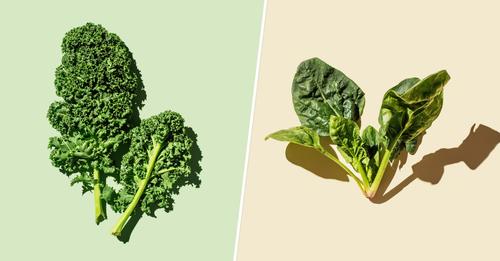Spinach and kale are both nutritious leafy greens and popular superfood bases for salads.
Leafy greens are packed with vitamins, minerals and antioxidants. Plus, they’re versatile and delicious both raw and cooked. It’s no surprise that the U.S. Department of Agriculture recommends eating leafy greens several times per week.
When choosing between kale and spinach, you may wondering if one is more nutritious. Is spinach or kale healthier? Dietitians compare the nutrition content, benefits and downsides of kale and spinach.
Spinach nutrition overview
Spinach is a mild and tender healthy salad green commonly eaten raw or cooked. At the grocery store, you’ll typically find spinach in its mature or baby form. These are similar nutritionally, but differ in size and texture.
The serving size for leafy green vegetables is two cups raw or one cup of cooked, per the USDA. According to the USDA database and the National Institutes of Health Office of Dietary Supplements, two cups or about 60 grams of raw spinach provides roughly:
- Calories: 14
- Carbohydrates: 2 grams
- Protein: 1.6 grams
- Fiber: 1.2 grams
- Vitamin K: 290 micrograms (241% of daily value)
- Vitamin A: 282 micrograms (32% of daily value)
- Folate: 116 micrograms (30% of daily value)
- Vitamin C: 17 milligrams (18% of daily value)
In addition to vitamins K and A, spinach is rich in folate and a good source of iron, potassium and magnesium.
Spinach is packed with antioxidants, such as quercetin, which have anti-inflammatory properties and may help protect against heart disease, diabetes and cancer, TODAY.com previously reported.
Kale nutrition overview
Kale is a leafy green that is part of the cruciferous family, a nutrient-dense group of vegetables. At the store, you’ll find several types of kale, such as curly, dinosaur, red or baby kale. These are similar nutritionally but vary in texture and flavor.
According to the USDA and NIH, about two cups or 60 grams of raw kale provides roughly:
- Calories: 27
- Carbohydrates: 3 grams
- Protein: 2 grams
- Fiber: 2 grams
- Vitamin K: 226 micrograms (188% daily value)
- Vitamin C: 38 milligrams (42% of daily value)
- Vitamin A: 100 micrograms (11% of daily value)
- Calcium: 104 milligrams (10% of daily value)
Kale also provides folate, iron and manganese, and it’s rich in antioxidants, including vitamin C and flavanoids.
“Kale is packed with beta-carotene and the sight-saving nutrients lutein and zeaxanthin,” Frances Largeman-Roth, registered dietitian and author of “Eating in Color,” tells TODAY.com
Spinach vs. kale benefits
Spinach and kale are both rich in nutrients and low in calories, making them excellent additions to a healthy diet, Julie Stefanski, registered dietitian nutritionist and spokesperson for the Academy of Nutrition & Dietetics, tells TODAY.com.
The nutrients in these greens can help support healthy bones, vision and immune function, and lower the risk of chronic diseases and cancer. However, spinach and kale contain varying amounts of different nutrients — here are the main differences:
Vitamins
Leafy greens are known for being packed with vitamin K, which controls blood clotting and factors into bone health, says Natalie Rizzo, registered dietitian and nutrition editor for TODAY.com.
Spinach is a very rich source of vitamin K. One 2-cup serving provides more than twice the daily value, per the NIH. “Kale is also very high in vitamin K, providing more than 100% (in one serving), but it’s half of what you get in spinach,” says Stefanski.
Kale and spinach both contain vitamin A, which is important to maintain vision and immune function, says Rizzo. One serving of spinach has nearly twice as much vitamin A as kale.
However, kale provides much more vitamin C, Rizzo notes. Vitamin C is an antioxidant that strengthens the immune system, stimulates collagen production and promotes iron absorption. Two cups of raw kale provide 42% of your daily value, whereas spinach has about half as much vitamin C.
Minerals
Kale is a rich source of non-dairy calcium, an important mineral that contributes to strong bones, teeth and hair, says Rizzo. One serving of raw kale provides about 10% of your daily value of calcium, three times the amount in spinach.
Spinach contains more folate (vitamin B9) than kale, the experts note. “Folate plays a role in making DNA and metabolizing amino acids, (and) prevents neural tube defects in babies, so it’s important for pregnant women,” says Rizzo.
Both greens are vegetarian sources of iron, crucial for blood cell formation. Spinach has more iron per serving than kale, says Largeman-Roth.
However, spinach has low iron bioavailability (the amount the body can use) because it has compounds that inhibit iron absorption, per the NIH. “To help your body absorb this type of iron, pair spinach with a source of vitamin C, such as citrus,” says Largeman-Roth.
Fiber
Fiber is important for maintaining normal digestion and a healthy gut, says Rizzo. Eating enough fiber can also help lower cholesterol and promote heart health.
Spinach and kale both have fiber, but kale is the winner, the experts note. One serving of raw kale provides 2 grams of fiber compared to about 1.2 grams in a serving of spinach.
Protein
Protein is an essential macronutrient that helps the body build and repair tissues. It also keeps you feeling full and helps stabilize blood sugar levels.
Leafy greens aren’t considered a significant source of protein, says Stefanski, but they do provide some. Kale has slightly more protein (about 2 grams per serving) than spinach, Stefanski adds.
Which is healthier, spinach or kale?
Spinach and kale are both nutritious leafy greens, but is one ultimately healthier?
“No, they are both very healthy,” says Rizzo. Kale and spinach provide similar amounts of macronutrients and varying amounts of different vitamins and minerals. The healthiest choice for you will depend on your needs and goals, the experts note.
Kale is slightly higher in fiber and protein, but spinach is lower in calories and carbs. Spinach contains more of vitamins K, vitamin A, and folate, but kale has more vitamin C and calcium. Both are rich in antioxidants that help protect against cancer, says Stefanski.
“If weight management is on your mind, they’re both very low-calorie and help you feel full,” Stefanski adds.
Choose the leafy green you like the best, the experts say.
“Some people prefer the hearty and chewy texture of kale, (and) others prefer the softer spinach,” says Rizzo. Spinach wilts easily into soups or pasta and blends better into smoothies, while kale takes longer to cook — but it makes great oven-baked chips.
Fortunately, you don’t have to choose one. The experts recommend eating a variety of leafy greens to get a variety of nutrients.
Risks of spinach and kale
While both spinach and kale are generally safe to eat in moderation, but there are some potential downsides to consider.
Leafy greens are rich in vitamin K, which is essential for forming blood clots. Spinach has more vitamin K than kale, but both provide over 100% of your daily value per serving.
High levels of vitamin K can interact with blood thinners (such as warfarin), says Largeman-Roth, and may decrease effectiveness. If you have underlying conditions or take medications, check with your doctor before increasing your leafy green intake.
Raw spinach is high in oxalates, which bind to minerals like calcium and prevent the body from absorbing them, says Stefanski. Oxalates can increase the risk of kidney stones in some people, per the National Kidney Foundation.
Kale can be hard to digest and cause gas or bloating, says Stefanski, adding that it’s best to start with a smaller volume and gradually increase your intake.
Cooked vs. fresh kale and spinach
Kale and spinach are both healthy raw or cooked, the experts note, but they can have slightly different nutritional values after cooking. “Some nutrients go up and become more concentrated, and some go down,” Stefanski says.
Raw spinach provides more fiber and antioxidants, but boiled spinach has more vitamin A, per the Cleveland Clinic. Boiling also reduces oxalates, so the body can absorb more iron and calcium.
Raw kale has more fiber, minerals and antioxidants, but cooked kale is easier to digest and tastes less bitter.
When eating kale or spinach, make sure to wash them well first to remove any dirt, microorganisms or chemicals; or buy pre-washed packaged greens, says Largeman-Roth.



